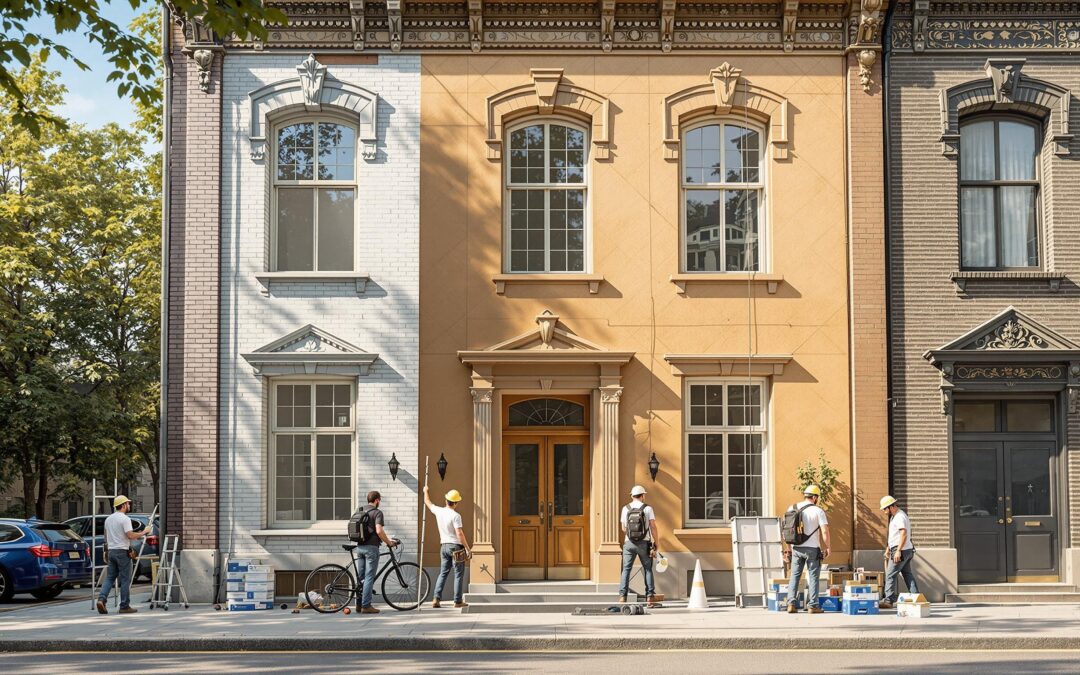Save energy and reduce noise in older UK buildings without losing their historic charm.
Older buildings often face issues like heat loss, high energy bills, and poor soundproofing due to single-glazed windows, solid walls, and traditional materials. Retrofitting these properties can be challenging, especially for listed buildings, where preserving original features like sash windows and decorative plasterwork is crucial.
Here’s what you need to know:
- Key Challenges: Difficult building structures, trade-offs between energy efficiency and soundproofing, restrictions for listed buildings, and limited space for upgrades.
- Solutions: Use modern sound control systems, internal or external insulation, and materials like mineral wool, PIR boards, aerogel, or cork to improve energy and acoustic performance.
- Best Practices: Start with an acoustic assessment, implement quick, non-intrusive fixes, and plan larger upgrades during maintenance periods.
Balancing energy efficiency, soundproofing, and heritage preservation requires careful planning and compliance with UK building regulations. Consult an expert to craft a phased retrofit strategy tailored to your building.
Tips from Experts on Successfully Retrofitting Old/Traditional …
Common Retrofitting Problems
Retrofitting older buildings comes with its own set of challenges, especially when trying to balance energy efficiency, soundproofing, and preserving the building’s original character. Here are four common issues that often arise:
Building Structure Challenges
Older buildings with solid masonry walls or narrow cavities make it difficult to add insulation or soundproofing without affecting the original structure.
Energy vs. Soundproofing Trade-offs
Improvements for heat retention often don’t reduce noise levels, and soundproofing materials can sometimes interfere with insulation. Finding a solution that addresses both needs requires careful planning.
Restrictions for Historic Buildings
Listed buildings must maintain their original features, requiring the use of approved materials and obtaining necessary permissions. These regulations can limit what retrofitting work is possible.
Space and Access Limitations
Tight corridors and stairwells can make it hard to transport and install large materials. Careful planning and phased work are essential to minimise disruption for building occupants.
Next, we’ll look at effective retrofit methods that can help tackle these challenges.
Effective Retrofit Methods
To tackle the balance between energy efficiency and soundproofing, consider sound control systems that take up little space and avoid major construction work.
Sound Control Systems
These systems enhance both sound insulation and thermal efficiency without needing structural changes. For example, Sound of Silence offers services that include consulting, testing, and installation for commercial, residential, industrial, and heritage sites.
Their consultants analyse a building’s acoustics and recommend the best control systems, ensuring that historic features remain intact.
From here, let’s look at wall and window retrofit options that can further improve both energy performance and soundproofing.
sbb-itb-06ab728
Implementation Steps
After reviewing retrofit methods, it’s best to use a phased rollout to keep costs manageable, minimise disruption, and ensure compliance.
Step‑by‑Step Upgrades
-
Initial assessment
Start with acoustic testing to identify key areas of concern and plan a focused retrofit approach. -
Quick wins
Add simple, non-intrusive measures to achieve immediate improvements in both soundproofing and energy efficiency. -
Major upgrades
Plan larger projects, like advanced insulation or integrated sound-control systems, to coincide with maintenance periods or when spaces are unoccupied.
Make sure all work complies with Building Regulations Part E (sound) and Part L (energy). If the property is listed, secure the necessary consent before starting.
Retrofit Method Analysis
Phased upgrades require careful evaluation of both internal and external retrofit methods to meet heritage preservation, energy efficiency, and acoustic performance goals.
Inside vs Outside Methods
- Internal retrofit: Keeps the external façade intact, avoids the need for scaffolding, and works well with structural constraints. However, it reduces usable floor space and demands precise detailing.
- External insulation: Offers better thermal and acoustic performance but changes the building’s appearance, which may require planning permission in conservation areas. It also adds scaffolding costs.
- Hybrid approach: Combines internal and external methods to strike a balance between performance, cost, and heritage considerations.
Material Options
- Mineral wool: A cost-effective, breathable option for cavity walls and lofts. It provides both thermal and sound insulation.
- PIR boards: Slim, high-performance thermal panels with moderate acoustic benefits, suitable for internal wall linings.
- Aerogel: Extremely low thermal conductivity and space-saving, making it ideal for sensitive interiors. When paired with traditional insulation, it significantly improves energy and acoustic performance.
- Cork products: Eco-friendly and breathable panels that regulate moisture and absorb sound effectively.
Choose materials based on how well they align with the building’s fabric, moisture control needs, and site accessibility.
Cost and performance metrics should be reviewed next to finalise the most suitable retrofit strategy.
Heritage structures require specialised acoustical treatment to preserve existing character and comply with UK building regulations.
Summary and Next Steps
Using the retrofit methods and material choices discussed earlier, refine your plan with guidance from experts. Aim to balance energy efficiency, sound performance, and the preservation of heritage features through a carefully planned retrofit strategy.
Modern acoustic treatments can improve both energy use and sound control in heritage buildings when applied correctly. These specialised solutions must comply with preservation guidelines while adhering to current UK building regulations.
Schedule a site visit with an acoustic consultant experienced in heritage buildings. This will help you finalise material selection, secure necessary permissions, and begin a phased retrofit that meets all regulatory requirements.

